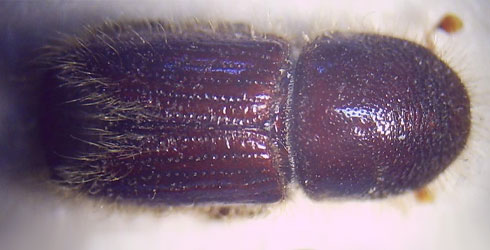Ips typographus (8-toothed spruce bark beetle)
Ips typographus (Linnaeus,1758) or as it is commonly known, the 8-toothed spruce bark beetle, is one of the most commonly encountered of the bark beetles (family Scolytidae). It is also potentially one of the most destructive, reaching pest proportions when outbreaks occur.
It prefers to attack trees already suffering damage from adverse weather conditions, though it can attack living and healthy trees if populations reach pest proportions.
It mainly lives in the bark of the Christmas tree, Norway spruce (Picea abies) but will attack other pines and larches.
The chambers created by the larvae of this beetle can be seen in the thin bark and the surface of the wood, which is a behavioural characteristic unique to this species.
Like most bark beetles it is small, 4.2mm–5.5mm and bears a series of 4 ‘teeth’ along the base of each elytra (wing case) from which it gets its name.
Distribution
This species is found throughout Europe and northern Asia. Although outbreaks have occurred in the UK, this species is not currently recorded here, but is regularly intercepted at ports.
Species detail
-

Biology
This beetle uses a fungal weapon to weaken the tree’s defences. Find out how it orchestrates its attack on the host tree.
-

Behaviour
Ips typographus is usually found in trees that were already damaged. But infestations can also affect healthy trees, and the beetle carries a fungus that can stain the wood blue, reducing its value. Find out more.
-

Future study and control
Find out what can be done to control this beetle.
-

References
Get reference material for Ips typographus.
Images

Pheromone trap containing Ips typographus
© Beentree, Creative Commons Attribution-Share Alike 3.0 Unported
Elytra detail of Ips typographus.
© Fdcgoeul
Elytra detail of Ips typographus.
© Fdcgoeul
Spruce killed by Ips typographus.
About the author
A word from the author
"This beetle highlights the geographical exchange of insects that is going on all over the world, as a result of global warming and trade between nations. This beetle makes us think about sustainability - if forests are managed well then this species’ populations do not reach pest proportions.
"When you are choosing your Christmas tree this season, think about whether you can buy rooted stock, (which can then be replanted) or if not, recycle your tree once the festive season is over."

